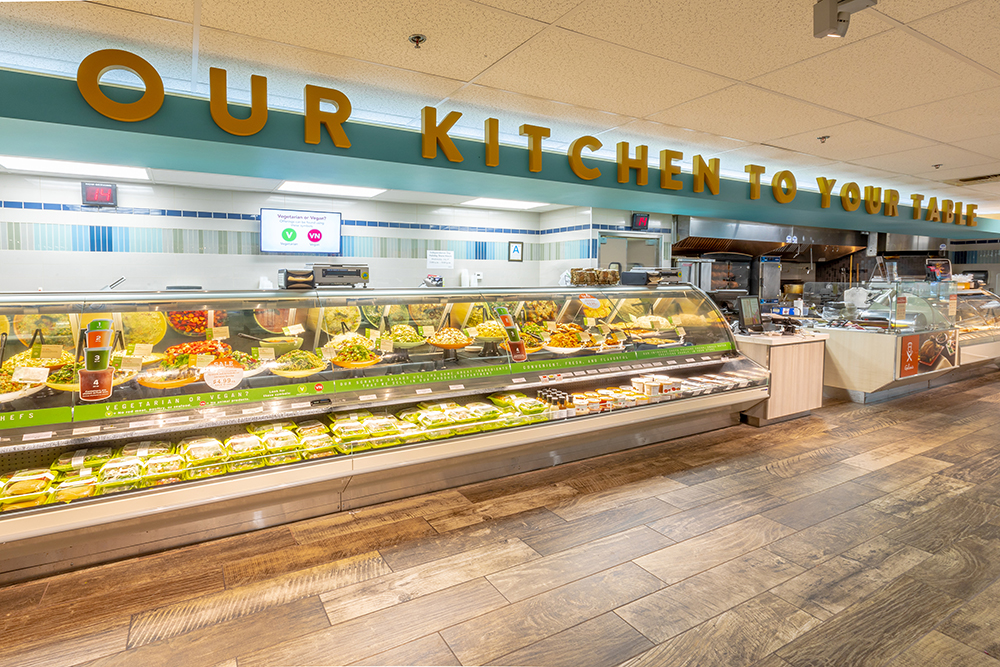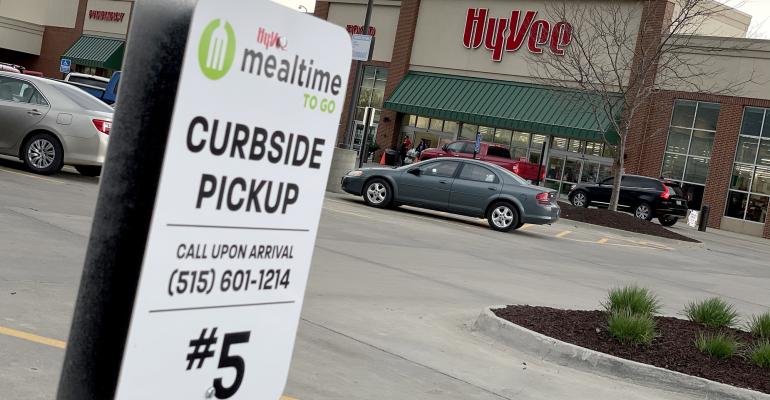Supermarket prepared foods operations were pressured in 2020 amid restrictions on in-store dining and reductions in trip frequency, as consumers focused largely on stock-up trips to load their pantries and freezers with shelf-stable foods.
But some retailers quickly adapted by leveraging online opportunities for prepared-foods sales.
“Prepared deli foods, and the prepared-food area of the fresh departments really got hit hard,” said Eric Richard, industry relations coordinator at the International Dairy Deli Bakery Association. “It was very discouraging, because leading into the pandemic, deli prepared and foodservice were really leading in the fresh category that we cover.”
Sales of prepared foods tended to surge around the holidays, he said, and decline significantly, year-over-year, at other times. In some cases, consumers who were enjoying celebrations at home boosted retailer’s prepared foods sales.
“Deli entertaining had a huge February,” said Angela Bozo, education director with IDDBA, in a recent report from the association. “The February results included two holidays, the Super Bowl and Valentine’s Day, which are both typically holidays where a significant portion of the food dollar flows to foodservice. The 10% increase in deli entertaining is an encouraging confirmation that people want to celebrate holidays and special occasions, albeit differently.”
IDDBA research from IRI showed that sales of deli prepared were down by more than 40% in the early months of the pandemic, however, and have yet to fully recover.
Some retailers already had well-established prepared foods offerings built into their curbside pickup and delivery programs, which may have helped buoy their sales during the past year, Richard said, and others scrambled to bolt such capabilities onto their e-commerce platforms.
“People are comfortable buying prepared foods and fresh products in general now online, and if the retailers do a very good job of fulfilling these orders to the consumer’s satisfaction, they're going to keep ordering online,” he said.
Consumers appear to be returning to their normal shopping routines, Richard said, which bodes well for in-store prepared foods, although he noted that the increase in e-commerce sales that retailers experienced during the past year could be a signal that grocers need to ensure that they can continue to drive prepared foods with those orders.
Gelson’s offers meals to go online
Southern California’s Gelson’s Markets was among the retailers that pivoted to online ordering for prepared foods last year.
“We established a safe and easy way for our customers to enjoy restaurant-quality food as an alternative to cooking at home and as a substitution for restaurants that were closed,” said Paul Kneeland, vice president of fresh operations at the Encino, Calif.-based upscale grocer, of the Gelson’s Kitchen Meals To Go program, which is available via online ordering for curbside pickup.

Gelson’s Kitchen Meals To Go program is available via online ordering for curbside pickup.
Items on the menu range from a Spaghetti Rustico Dinner for Two for $20 to a Prime Rib Dinner for Two for $40. Other options include fried and rotisserie chicken dinners for four, and other beef, pork, poultry and seafood dinners, each of which comes with the ability to select from an extensive menu of side dishes.
“As we moved forward, we increased the menu to offer additional choices and sides that we think enhanced our customer experience and helped address the taste buds of a diverse family unit,” Kneeland said.
He noted customers also shifted to prepackaged, grab-and-go meals, and Gelson’s expanded those offerings as well.
One of the key learnings of moving the program online was that older customers were not always able to figure out how to order online, although they often received help from a neighbor or another member of the household. That could impact how the program is marketed going forward, Kneeland said.
“We do expect the online trend to continue, and we are continuously adjusting that experience to make it better and more convenient for the customer,” he said. “Ultimately we need to continue delighting our customers with a varied assortment of restaurant-quality food that can be delivered through a multitude of vehicles — online, pickup, in-store and delivery — and make each system of delivery a consistent experience, which is very important.”
Meanwhile Gelson’s was preparing to reopen its famous in-store wine bars, at first with outside versions, followed a reopening of the bars inside the stores when the mandate to wear masks is lifted, sometime after the June 15 date that California had set as a target for businesses to reopen, Kneeland said.
Hy-Vee adds foodservice website, delivery
West Des Moines, Iowa-based Hy-Vee, which is known for its extensive restaurant and prepared-foods offerings, quickly established a foodservice delivery partnership with DoorDash early on in the pandemic, said Angela Waltz, Hy-Vee’s group vice president of restaurant development, and also created its own prepared foods website called Hy-Vee Mealtime To Go. The site allows customers to order hot, prepared foods along with take-and-bake meals, all of which are available for curbside pickup or delivery in as little as 30 minutes, or can be scheduled for a future time.
“We continue to expand our partnerships with third-party delivery companies because we believe our customers and restaurant guests have created new habits when it comes to eating away from home that will likely continue to some degree for some time,” she said.
Waltz said Hy-Vee expects that its to-go foodservice business will comprise a larger share of its volume than it was before the COVID-19 pandemic, although she said the company had begun to see a steady increase in its in-person dining business.
“We also anticipate that cocktails-to-go — where allowed by state— will create a point of difference,” she said.
For Hy-Vee, the impacts of the pandemic on its sit-down restaurant operations mirrored the impact that traditional foodservice operators endured for the past year.

Hy-Vee expects that its to-go foodservice business will comprise a larger share of its volume than it was before the COVID-19 pandemic.
The company, which operates in eight Midwestern states, had to closely monitor regulations in each state to ensure that it was strictly following guidelines, said Waltz. The Hy-Vee restaurant team held regular companywide webinars to continually set expectations and clarify what the specific restrictions were as they evolved over time, she said.
“In the early days of the pandemic, we created companywide standards as it related to the pandemic and specific protocols for our foodservice departments and restaurants, many of which exceeded the expectations set forth by states and counties,” she said.
For dining inside Hy-Vee stores and at Hy-Vee-owned Wahlburgers restaurants, the company created a uniform system to close specific tables to help enforce social distancing, Waltz said. Tables that are open for seating have a table tent indicating that the table is “sanitized for your safety.”
Hy-Vee also rolled out table tents with QR codes that link to its menus to create a more contactless experience.
“We work hard to clearly communicate to our guests with limited interaction between guests and staff,” Waltz said.
Hy-Vee also installed plexiglass partitions between booths, which she said will remain in place “for the foreseeable future.”
As restrictions on in-store dining are lifted, the company is rigorously monitoring its sanitization protocols, Waltz said.
“We emphasize the importance of making our guests feel safe and helping them feel comfortable as we move closer toward a post-COVID world in the coming months,” she said. “We will not relax our standards, and will adhere to this ‘new normal’ to keep employees and customers safe.”
Waltz said that Hy-Vee’s restaurant and foodservice teams took advantage of the lower volume that foodservice experienced during the past year, and worked on some new initiatives that the company plans to launch this summer.
Walmart goes with Ghost Kitchens
Walmart, the nation’s largest retailer, is piloting a different take on prepared foods as it rolls out Ghost Kitchen Brands’ hybrid virtual brand/ghost kitchen concept in dozens of its stores in the U.S. and Canada.
The new service will allow shoppers in those locations to select items from the menus of about 15 national and regional restaurant and CPG food concepts, including Quiznos, Saladworks and others, combined in a single order. The on-site kitchens, meanwhile, will also serve as delivery hubs for those brands via third-party delivery services such as Uber Eats.
“In a lot of ways, we are like a virtual food court,” said Marc Choy, president of Toronto-based Ghost Kitchen Brands.
Choy, who spent 15 years as an executive at Quiznos before joining Ghost Kitchen brands, said a key difference between Ghost Kitchen Brands and other ghost kitchen operators, such as Kitchen United and Cloud Kitchens, is that Ghost Kitchen Brands operates all of the restaurant concepts in its locations itself, rather than leasing space to other operators.
The company has licensing or distribution agreements with each of its restaurant partners, and uses the same ingredients, training, marketing and operational support as the brick-and-mortar locations of those brands.
“We want the customer to have the same experience with us that they would have with any of these brands’ brick-and-mortar stores,” said Choy.

Walmart’s partnership with Ghost Kitchens offers food to go ordered via touchscreen as well as delivery hubs via third-party delivery services such as Uber Eats.
The Ghost Kitchens concept has been installed in two Walmart stores in Ontario, and three more were scheduled to come online in April, including two in Quebec, along with six Walmart installations in New York state. Another 33 are under construction, and as many as 50 additional locations could roll out across Canada and the U.S. this year, Choy said. The company also operates 20 stand-alone outposts not affiliated with Walmart stores.
“We believe in Ghost Kitchens' strategy and vision, and we’re very excited to be the first retailer to team up with Ghost Kitchens,” said Sam Hamam, senior director of licensees at Walmart Canada. “We’re always looking at ways to improve our customer shopping experience with greater access to affordable products, services and brands.”
Each Ghost Kitchens offers slimmed-down menus from the restaurant concepts to make operations more efficient. Ghost Kitchens' Quiznos menu includes only the top 15 sandwiches, for example, rather than the two dozen or so in a traditional Quiznos. Similarly, Ghost Kitchens' Saladworks offer only salads, and do not offer that chain’s sandwiches or paninis, Choy explained.
The Walmart Ghost Kitchens operate with minimal person-to-person interaction — customers order via an array of four, 55-inch touchscreen kiosks, then receive a receipt via text, and another text when their order is ready. This allows the restaurants to operate efficiently with a staff of only two or three employees per location, and provides a convenience to consumers, who have the ability to not only combine orders from multiple brands on one ticket, but also to continue shopping while their order is being prepared. Customers can also download the menu via QR codes located alongside the kiosks for a contactless ordering experience.
Ghost Kitchen Brands started a little over a year ago as a delivery-only concept with the goal of allowing customers to combine items from multiple restaurant brands in a single order. The response was positive, Choy said, and led the company to consider expanding to customer-facing venues with heavy foot traffic such as Walmart or other big-box retail stores.
He said the company would ideally like to have a portfolio of 30-40 restaurant brands to select from, with 15-20 available at each location. Currently all of the company’s brands are available at every Ghost Kitchens location.
“As we grow, there will be a realization that some brands will work better than others in some markets,” said Choy.





